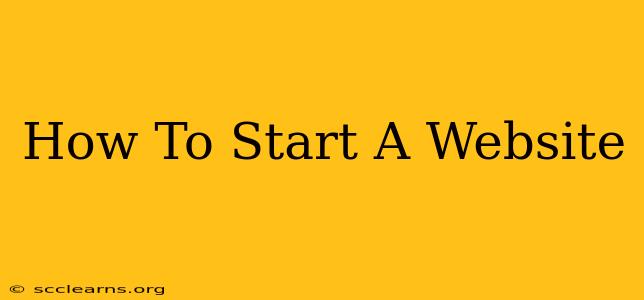Starting a website might seem daunting, but with a clear plan and the right resources, it's achievable even for complete beginners. This guide breaks down the process step-by-step, covering everything from choosing a domain name to launching your site.
1. Define Your Website's Purpose and Goals
Before diving into the technical aspects, clarify your website's purpose. What are you hoping to achieve? Are you creating a blog to share your passion, an online store to sell products, or a portfolio to showcase your work? Defining your goals will guide your decisions throughout the process. Consider:
- Target Audience: Who are you trying to reach? Understanding your audience will help you tailor your content and design.
- Content Strategy: What kind of content will you create? This is crucial for attracting and engaging your visitors.
- Monetization Strategy (if applicable): How will you generate revenue? This could involve advertising, affiliate marketing, selling products or services, or memberships.
2. Choose a Domain Name and Web Hosting
This is where your website gets its online address and a place to live.
Domain Name Selection:
Your domain name is your website's address (e.g., www.example.com). Choose a name that:
- Is relevant to your website's content: Make it easy for people to understand what your website is about.
- Is easy to remember and spell: Avoid complicated or confusing names.
- Is available: Check if the domain name is already registered using a domain registrar like GoDaddy or Namecheap.
- Includes relevant keywords (if possible): This can improve your search engine ranking.
Web Hosting:
Web hosting is where your website's files are stored and served to visitors. Choose a hosting provider that offers:
- Reliable uptime: Your website should be available to visitors most of the time.
- Sufficient storage and bandwidth: This depends on the size and traffic of your website.
- Good customer support: You'll want help if you run into problems.
- Scalability: The ability to upgrade your plan as your website grows. Consider shared, VPS, or dedicated hosting depending on your needs and budget.
3. Select a Website Platform
Several platforms make building a website easy, even without coding experience.
- WordPress: The most popular website platform, known for its flexibility and vast plugin ecosystem. It's great for blogs, business websites, and e-commerce stores.
- Wix: A user-friendly drag-and-drop website builder, ideal for beginners who want a quick and easy solution. It's excellent for creating visually appealing websites.
- Squarespace: Another popular drag-and-drop builder known for its stylish templates and ease of use. It's a good option if you prioritize design.
Choosing the right platform depends on your technical skills and website needs.
4. Design and Develop Your Website
Once you have your domain, hosting, and platform, it's time to build your website. This involves:
- Choosing a theme or template: This provides the basic structure and design of your website.
- Customizing your website: Add your content, images, and other elements to make it unique.
- Installing plugins or apps (if applicable): These add extra functionality to your website.
5. Optimize Your Website for Search Engines (SEO)
Getting your website found by search engines like Google is crucial. SEO involves optimizing your website's content and structure to rank higher in search results. Key aspects include:
- Keyword Research: Identify relevant keywords that people use to search for information related to your website.
- On-Page Optimization: Optimize your website's content, titles, and meta descriptions to include your target keywords.
- Off-Page Optimization: Build backlinks to your website from other reputable websites.
- Technical SEO: Ensure your website is technically sound and loads quickly.
6. Launch and Promote Your Website
Once you're happy with your website, it's time to launch it! After launching, promote your website through various channels such as:
- Social Media Marketing: Share your website on social media platforms.
- Email Marketing: Build an email list and send out newsletters.
- Content Marketing: Create high-quality content that attracts and engages your audience.
- Paid Advertising: Consider using paid advertising platforms like Google Ads or social media ads.
Conclusion:
Starting a website is a journey, not a sprint. Take your time, plan carefully, and don't be afraid to ask for help. With dedication and the right approach, you can create a successful online presence. Remember to continuously learn and adapt to the ever-evolving world of web development and digital marketing.

